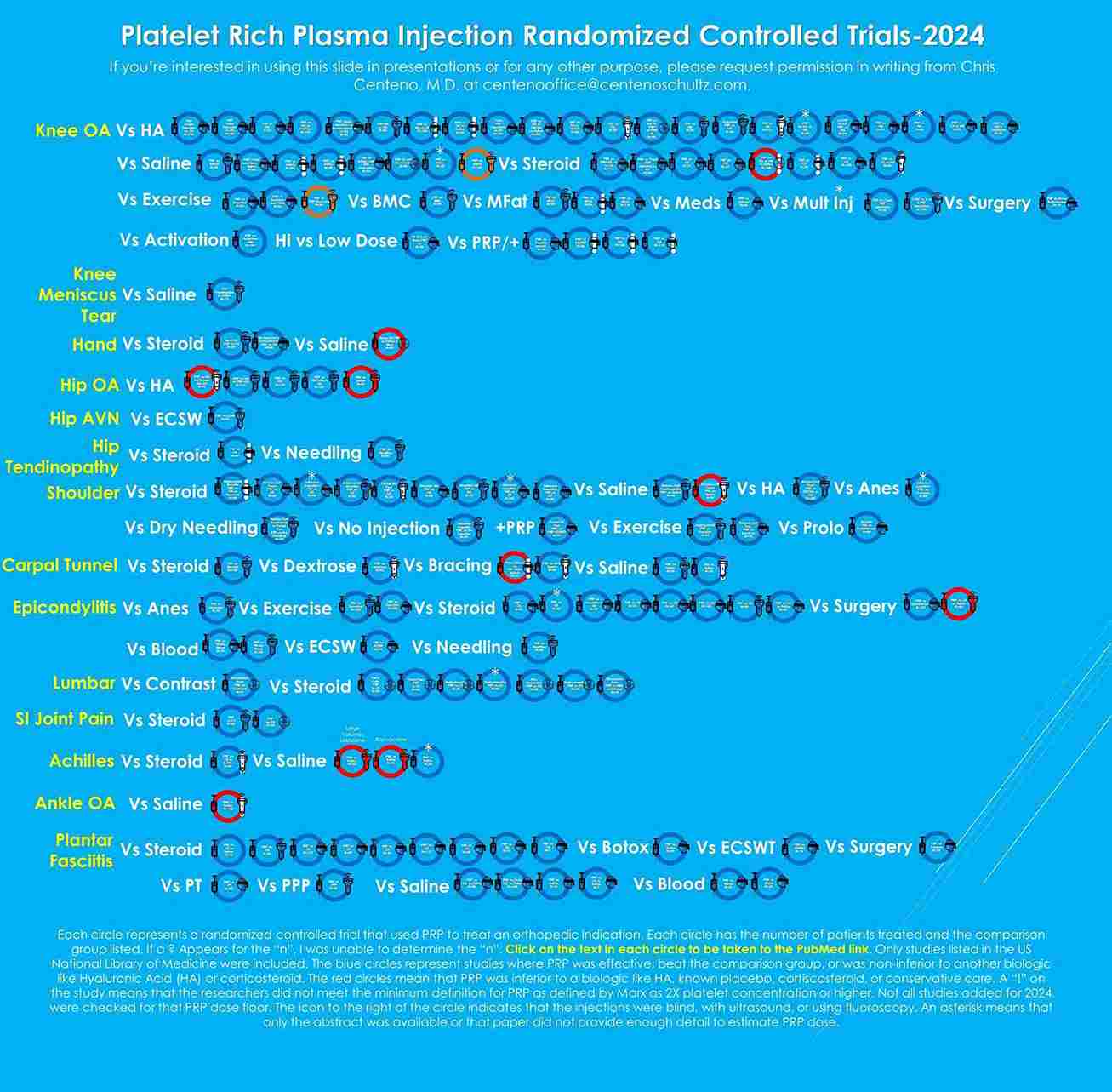My 2024 PRP RCT Infographic
[A companion analysis to this blog was posted after this piece was published and can be seen here.]
Every year, I perform a deep dive into the orthobiologic literature to see what’s been published. This is part of my job as CMO of Regenexx, and it’s also a great opportunity to produce an infographic that others in the orthobiologics community can use. This is my 2024 edition of the PRP randomized controlled trials literature, which adds another several dozen studies over 2023. Let’s dive in.
Past PRP Infographics
I’ve been at this PRP infographics creation gig since 2019. That’s because 2018 was a banner year for PRP RCTs as this was when the clinical science behind PRP began to coalesce and mature. Here are my past infographics:
- PRP RCTs 2019
- Knee Arthritis PRP RCTs 2020
- PRP Knee Arthritis RCTs 2022
- PRP RCTs for Carpal Tunnel 2022
- PRP RCTs in Spine 2023
- PRP RCTs 2023 and Study Failure Analysis
My 2024 Infographic
By my count, in the far too early, pre-dawn hours of Tuesday morning, there are now 144 PRP RCTs. Only 17 show that PRP is inferior to the comparator, and as I have previously reported, most of those studies never used real PRP (at least 2X concentrated platelets). 9 studies weren’t about a standard of care comparator. So, even if you include the fake PRP studies, that’s an RCT failure rate against a standard of care comparator of 13%.
It’s insane to think we have 127 successful PRP RCTs as of the summer of 2024. Knowing the orthopedic surgery RCT against sham/placebo literature well, more RCTs support PRP use than exist in the entire field of orthopedic surgery. The surgeons reading this right now may be yelling at the screen because they see orthopedic surgery RCTs published all the time. However, 99% of those are for surgery or device X versus surgery or device Y, not whether surgery X or Y is better than placebo, sham, or physical therapy.
This year, several dozen new studies and an entire section on plantar fasciitis were added. Of note is that the PRP spine literature has picked up, and we’re still seeing new knee OA RCTs published.
How to Use This Infographic
Click on the image above to see the PDF. Each circle links to a PubMed abstract or full-text article. Red circles are trial failures where PRP was inferior to the comparator. If you know of studies I have missed that are listed in Pubmed, please write to me at my office email, which is centenooffice@centenoschultz.com. If you find any bad or broken links, please let me know. If you want to use this document for a lecture or physician educational purposes (not patient marketing), that’s fine; just let me know by sending me an email. I produce these infographics to get the word out to other physicians and policymakers.
The upshot? If anybody says we don’t have enough published data on PRP yet, you can now officially break out laughing and begin rolling on the floor. While more research is always welcomed, we have more basic efficacy data on PRP than on the entire field of orthopedic surgery. Everyone using PRP daily in patients should be very proud of that fact!
[This blog was updated on 7/17/24 with an edited infographic. Several bad links were cleaned up, and additional information was added.]

NOTE: This blog post provides general information to help the reader better understand regenerative medicine, musculoskeletal health, and related subjects. All content provided in this blog, website, or any linked materials, including text, graphics, images, patient profiles, outcomes, and information, are not intended and should not be considered or used as a substitute for medical advice, diagnosis, or treatment. Please always consult with a professional and certified healthcare provider to discuss if a treatment is right for you.

